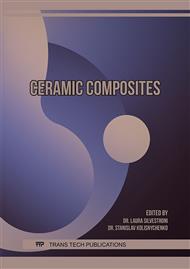p.152
p.159
p.165
p.172
p.180
p.188
p.194
p.200
p.208
Modelling of Hysteresis Behavior of Ceramic Matrix Composites
Abstract:
Under cyclic loading, the fiber-reinforced ceramic matrix composites exhibits hysteresis behavior due to the friction stress. When the matrix/fiber debonding occurs, the shear stress is transferred by friction stress on the debond surface. The friction stress is derived from the equilibrium equation of debond fiber in the unit cell. The result indicates that friction shear stress of a single debond fiber can be described by bilinear law due to the static friction and sliding friction. The nonlinear characteristic of friction stress at macro scale attributes to the distribution of the fiber pullout length. The hysteresis loops arise due to the friction stress and the shape is dominated by the evolution of friction during loading/unloading process. The model decoupled the shear stress into two independent terms: the first term represents the shear stress on well bond interface and the second term represents friction shear stress on debond interface. The method developed in this paper is employed to study the hysteresis behavior of C/SiC composite subjected to arbitrary cyclic load. The hysteresis behavior of C/SiC composite is predicted and compared with experimental data.
Info:
Periodical:
Pages:
180-187
Citation:
Online since:
March 2019
Authors:
Price:
Сopyright:
© 2019 Trans Tech Publications Ltd. All Rights Reserved
Share:
Citation:



